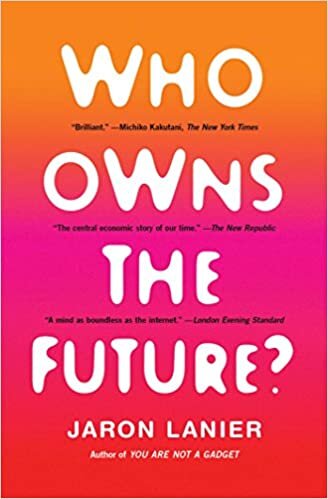I will admit that for the majority of the time I spent reading this book, I was lost. I even cheated and went online to watch the corresponding talk Lanier gave in Berkeley to promote the book. The digital equivalent of crib notes. I found myself having to repeat the title of the book over and over in my head to maintain even the slightest grip on what was being discussed. Lanier goes on and on about side notes and inside jokes only he knows, leading the reader into the deep end of a very complex world. Somehow with each turn of the page, he pulls it together in the last few sentences leaving your head spinning but still somehow clear on his point. So you read on. Towards the end of the book Lanier describes his work of designing video games, and the difficulty of mixing reward with challenge in just the right way so the user can stay engaged and get hooked, This is Who Owns The Future.
Overall, the idea is simple and easy to spit out. Describing it here is not a spoiler because the book contains so much more than just this hypothesis. 380 pages of every possible detail which would need to be considered to answer the question: What if people were paid for using the Internet?
He really does go all in on this and manages to tease out close to all the details necessary to consider this alternative reality seriously. It is impressive how his mind works. His ability to see the idea from a complete 360 degree perspective despite that idea being rather farfetched in this reader’s opinion.
As with all my book reviews, my goal is to somehow tie into the world of Industrial Design. With Who Owns the Future, I will admit, it’s a stretch. But what Lanier does best here is dream. He flips the whole world on its head. He makes gigantic, bold claims that seem unfathomable to even consider in today’s reality. The world he imagines is not like anything we have in our sights. Oh, the money I would pay to sit in the corner during the meeting where Lanier flips aside his dreads, blowing into his Khaen before laying into Jeffery Bezos about why he should start making less money for a little bit. Good luck!
What makes the book attractive to design is that the ideas are outlandish and fantastical. In my opinion, that is just what the doctor ordered in the realm of ID. There are too many designers out there content with merely sticking to the program, landing red dots for slightly better toaster ovens. We have bigger fish to fry! Lanier reminds us to unhitch ourselves from the norm and take off into the ether of free thinking. He holds the door open to allow the reader to gleefully run into the impossible. This is what the future of design needs most. Can I recommend the book? No. Would I recommend Lanier as a person to follow, as a luminary and an inspiration, absolutely.
